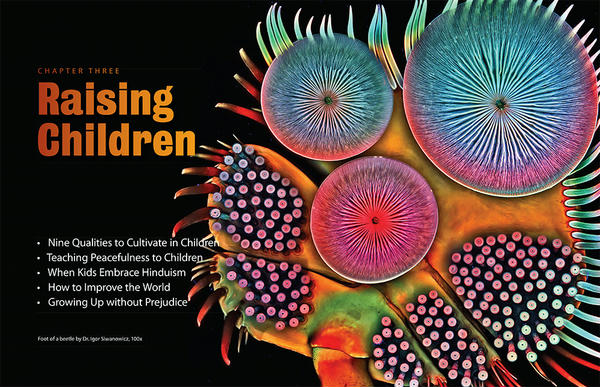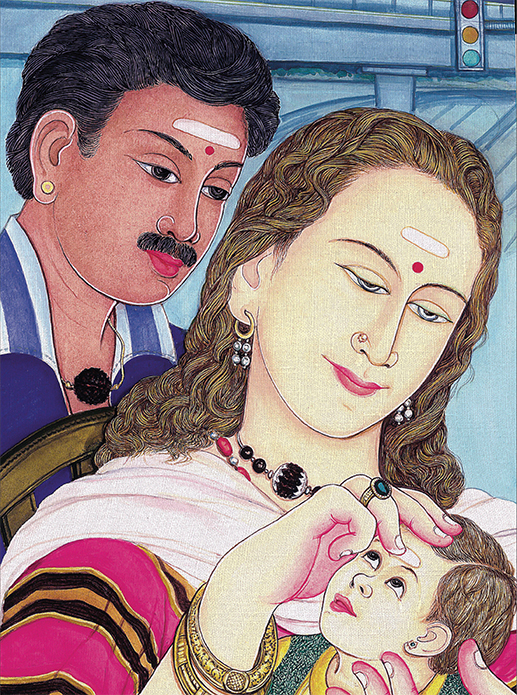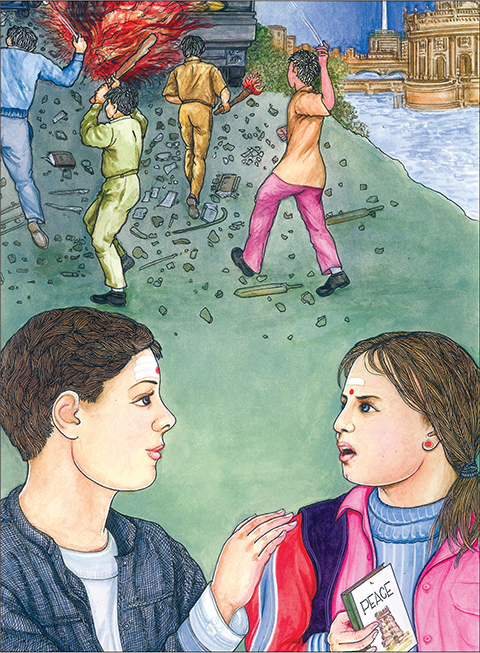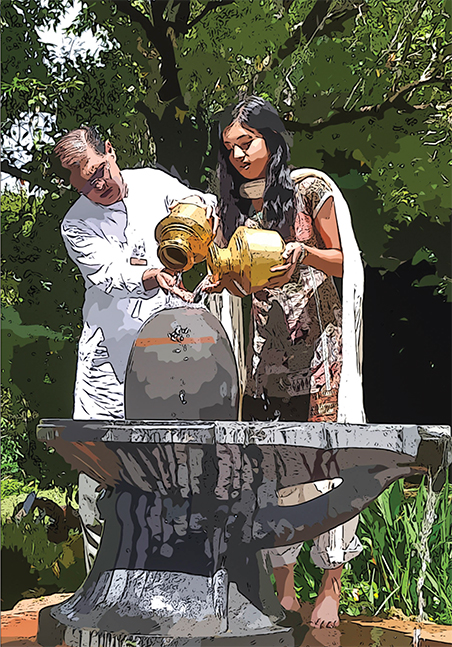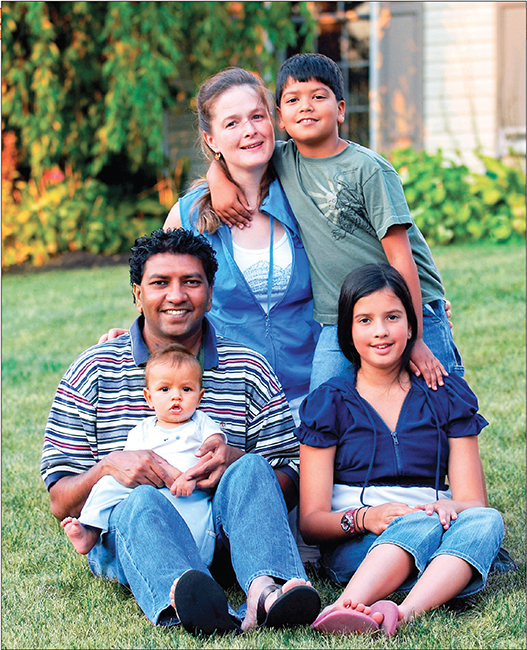PUBLISHER’S DESK • JULY 2002§
Nine Qualities to Cultivate in Children
______________________§
Children benefit immensely when parents, their first gurus, teach thoughtfully with specific goals in mind§
______________________§
BY SATGURU BODHINATHA VEYLANSWAMI§
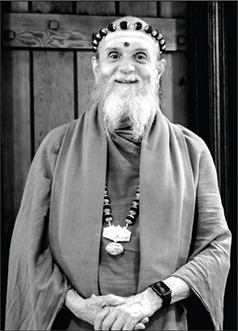 EVERY FATHER AND MOTHER IS INDEED A guru—in fact, an individual’s first guru, teaching by example, explanation, giving advice and direction. When we think of gurus, we automatically think of teaching; thus looking at parents as gurus highlights the importance of what parents teach their children, grandchildren and possibly even their great-grandchildren.§
EVERY FATHER AND MOTHER IS INDEED A guru—in fact, an individual’s first guru, teaching by example, explanation, giving advice and direction. When we think of gurus, we automatically think of teaching; thus looking at parents as gurus highlights the importance of what parents teach their children, grandchildren and possibly even their great-grandchildren.§
A swami is an individual’s second spiritual guru. A simple analogy will point out why swamis are deeply concerned about what parents teach their children. Imagine being a young man or woman’s second dance teacher. If the first teacher has not been systematic in teaching the basics of dance, the second teacher may end up spending years undoing what the first teacher ineptly taught before he can advance the student further.§
A common problem many individuals have when entering adult life is a negative self-concept. This is the sense of feeling that you are inherently flawed and inferior and that others are vastly superior to you. Parents create this in their children through frequent critical comments, such as “How could you do such a stupid thing?” “You’re so dumb!” “You’ll never amount to anything.” It can take the swami years of working with the individual to help him replace a low self-esteem with a sense of personal worth. This would be totally unnecessary if the parents had raised the child wisely to cultivate good character.§
There are nine key qualities we want our children to possess in order to be happy, religious and successful when they reach adulthood.§
1. Positive Self-Concept§
2. Perceptive Self-Correction §
3. Powerful Self-Control§
4. Profound Self-Confidence§
5. Playful Self-Contentment§
6. Pious Character§
7. Proficiency in Conflict Resolution§
8. Parental Closeness§
9. Prejudice-Free Consciousness§
We will explore each of these to see what children should be taught, or not taught, by the parents to develop that quality.§
1. Positive Self-Concept is in action when we think of ourselves as a worthy individual deserving of a wonderful life. Unfortunately, many children reach adulthood with a negative self-concept, feeling that others are better than they are and life has little to offer. A negative self-concept is developed through verbally running down a child. This can occur in two distinct situations. The first is simply making these kinds of remarks as a form of teasing or joking. This, of course, needs to be stopped and replaced with remarks that encourage and praise the child. Parents should also not allow their children to call each other names, such as fat or lame. When it comes to correcting misbehavior, it is wise to distinguish between the person and the behavior. The behavior was foolish, not the person. For example, “What you did was very foolish, but you are smart, and I’m sure you now know better and won’t do that again.” Having a positive concept about his outer self allows the child to accept the Hindu teaching that his inner self is a divine being, a radiant soul.§
2. Perceptive Self-Correction is shown when we are able to quickly learn the lesson from each experience and resolve not to repeat our mistake. How do parents develop this quality? By teaching kids that making mistakes is not bad. Everyone makes mistakes. It is natural and simply shows we do not understand something. It is important for the parent to determine what understanding the child lacks and teach it to him without blame. When parents discipline through natural and logical consequences, children are encouraged to learn to reflect on the possible effects of their behavior before acting. Such wisdom can be nurtured through encouraging self-reflection, asking the child to think about what he did and how he could avoid making that mistake again. Perceptive self-correction enables us to quickly learn from our mistakes, refine our behavior accordingly and thereby make more rapid progress on the spiritual path.§
3. Powerful Self-Control is restraining destructive emotions, such as anger, when we are tempted to express them. How is such control cultivated in children? It is through parents never expressing such emotions themselves. Children learn, by observing their parents, whether it’s acceptable to behave emotionally or not. It is by referring often to the ten restraints of Hinduism’s Code of Conduct, known as the yamas, finding illustrations of these ideals in daily life, on television and in movies. The yamas are noninjury, truthfulness, nonstealing, divine conduct, patience, steadfastness, compassion, honesty, moderate appetite and purity. It is through emphasizing the traditional Hindu imperative to maintain chastity until marriage. Self-control leads to self-mastery, enabling one to be more successful in achieving outer and inner goals.§
4. Profound Self-Confidence is exemplified when a child is confronted with a difficult task and his first response is the certainty that he can accomplish it. Unfortunately, many children reach adulthood lacking self-confidence and have as their first response the feeling that they will be unable to accomplish the task, as it is too difficult. How is profound self-confidence cultivated? It is first through the child’s possessing a positive self-concept. It is then through helping the child be successful at progressively more difficult tasks as he or she grows up. A pattern of many successes going into our subconscious mind is what produces the sense of self-confidence and the feeling that we will be equal to any task. For example, a father teaches his son carpentry from age ten through eighteen. Each year the father helps the son make something that is more complex, never giving him a project that is too advanced, praising each achievement. Self-confidence is cultivated by watching for failures at school or at home and compensating for them. If the child is shy and has trouble at school with public speaking, work personally or through a tutor to overcome that shyness so he or she can speak successfully at school in the future. Self-confidence makes one magnetic to success in both outer and inner endeavours.§
5. Playful Self-Contentment is expressed when a child’s usual mood is fun-loving, happy and satisfied. How is this developed? It is through the parents living and verbalizing the philosophy that life is meant to be lived joyously. It is by holding the perspective that happiness does not depend on external circumstances but is a consciousness we can claim, whether life is free of or filled with challenges. It is by teaching the children to be satisfied with what they have in the present rather than dissastified about what they don’t have. It is nurtured by the family spending time together filled with play and laughter. The ability to remain fun-loving, joyful, secure and content enables one to face with far greater equanimity the ups and downs of life.§
6. Pious Character is expressed when we naturally treat others with kindness, generosity and appreciation. It is fulfilled when we seek the blessings of God, Gods and guru throughout life. How can this be cultivated? It is through the parents demonstrating these qualities themselves. Children learn that this behavior is expected of them by observing their parents’ actions. It is by referring often to the ten observances of Hinduism’s Code of Conduct, known as the niyamas, and pointing out their relevance in daily life, on TV and in movies. The niyamas are remorse, contentment, giving, faith, worship of the Lord, scriptural listening, cognition, sacred vows, recitation and austerity. It is nurtured by teaching the child to worship and pray in the home shrine or at the temple before important events such as beginning a new school year or before final examinations. Pious conduct brings into our life the joys of Divine blessings.§
7. Proficiency in Conflict Resolution is exemplified when we work out disagreements with others by using intelligence and seeking for a win-win situation. How is this cultivated in youth? It is through the parents demonstrating these qualities themselves. Children learn that this behavior is expected of them by observing their parents’ actions. It is by sitting down with children any time they use anger, physical force or verbal injury to prevail in a conflict and discussing with them how it could have been settled with intelligence rather than violence. It is through replacing the idea of “I want me to win and you to lose” with that of “I win when everybody wins.” Illustrations of what to do and what not to do can be drawn from the people they see in television and movies. It is nurtured by parents following the wisdom of resolving their husband-and-wife disagreements before going to sleep, as this teaches by example the importance of facing and solving a conflict rather than fleeing from it. Proficiency in conflict resolution keeps our life sublime and our subsconscious mind free of the disturbances caused by memories of unresolved disagreements.§
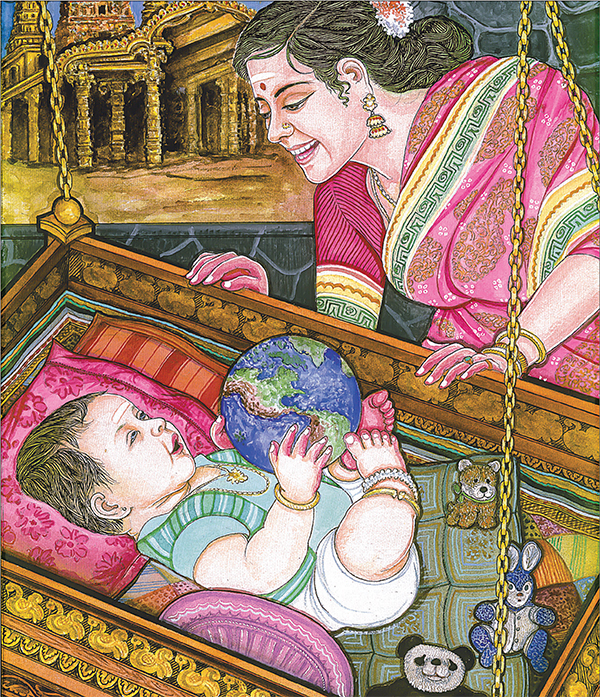
A. MANIVEL§
The hand that rocks the cradle rules the world: A mother sings a traditional lullaby as her child plays with a small Earth, signifying the global impact all mothers of the world have in passing along religious culture and values to their children. She is raising him near the Nallur Murugan Temple in Jaffna, Sri Lanka.§
8. Parental Closeness is fulfilled when children reach adulthood and choose to spend time with their parents because they really enjoy being with them. A strong bond of love and understanding exists. Sadly, we know of many instances when a boy reached adulthood, moved out of the home and maintained as little contact with his father as possible. How then is parental closeness developed? It is through expressing love by hugging and saying often the three magic words, “I love you.” Distance is developed by never expressing love. Closeness is nurtured by correcting a child’s misbehavior with positive discipline methods, such as time-out and appropriate natural and logical consequences, and using reason without blame and shame. The use of physical violence, anger, irrational punishments, blame and shame cause distance. Closeness comes when quality time is spent together in activities that all members of the family enjoy. It is developed by the father bonding with his sons and the mother bonding with her daughters, through developing common interests in hobbies or games and working on them together. It is protected when parents create a nonthreatening atmosphere of love in their home in which their children feel free to tell them everything they have done without fear of the consequences. They know their parents love them no matter what. Distance develops in a threatening atmosphere where children will keep secrets, each secret adding to the distance between the child and the parents. A loving relationship between child and parents powerfully influences all subsequent relationships, even one’s relationship with God.§
9. Prejudice-Free Consciousness manifests when we see God in everyone and embrace differences of ethnic background and religion. Are we born with prejudices? Absolutely not! These are all learned—at home, at school and elsewhere. How is a prejudice-free consciousness developed? It is through teaching our children that the whole world is our family and all human beings are divine beings. It is through complete avoidance of remarks which are racially or religiously prejudiced. It is through discussing with our children any prejudice they hear from others at school and elsewhere and correcting it. It is by teaching children to avoid generalizations about people and, instead, to think about specific individuals and the qualities they have. Again, television and movies can provide useful situations to discuss. It is through having our children meet, interact and learn to feel comfortable with children of other ethnicities and religions. Tolerant individuals help communities function with less friction and misunderstanding.§
Summary: A wise mother wrote to me recently on e-mail saying, “I truly believe we live out part of our karma through our children, and we grow and improve as they do.” Though we may think we are just helping our children be more happy, successful and religious, in truth we cannot separate ourselves from them. Their growth and spiritual evolution is our own as well.§
PUBLISHER’S DESK • JULY 2003§
Teaching Peacefulness to Children
______________________§
Cultivate a prejudice-free consciousness that readily embraces differences in race, religion and nationality§
______________________§
BY SATGURU BODHINATHA VEYLANSWAMI§
 CONDITIONS IN THE WORLD TODAY ARE certainly troubling—wars between countries, wars within countries, plus a growing threat of international terrorist acts. The shocking attacks in New York on September 11 naturally heightened everyone’s concern about these problems.§
CONDITIONS IN THE WORLD TODAY ARE certainly troubling—wars between countries, wars within countries, plus a growing threat of international terrorist acts. The shocking attacks in New York on September 11 naturally heightened everyone’s concern about these problems.§
One of the immediate consequences of 9/11 was the television coverage depicting people in a number of countries who do not much like, some even strongly hate, the United States, even to the point of wishing violence upon it. Watching these startling reports on television, we were again reminded of the extent and seriousness of the problem of prejudice in the world today.§
Attitudes of prejudice toward those of a different race, nation or religion can start simply as distrust, which can then deepen into dislike and deepen further into hatred, which can turn into a desire to inflict injury. Are we born with such attitudes? Certainly not. As children, we are taught them at home, at school and even in some religious institutions.§
In the last few months a number of resolutions have been passed objecting to the US war with Iraq. Thousands of people have objected by demonstrating in the streets all over the world, including the US. These actions are sincere and make a point, but they certainly do not address the core of the problem, which is hatred.§
People have been raised to hate those of different ethnic groups, faiths or countries. The solution, though admittedly a long-term one, is that we need, in the century ahead, to teach all children tolerance, openness to different ways of life, different beliefs, different customs of dress and language. We need to stop teaching them to fear those who are different from themselves, stop teaching them hatred for peoples of other colors and other religions, stop teaching them to see the world as a field of conflict, and instead instill in them an informed appreciation and a joyous reverence for the grand diversity we find around us. Instead of teaching children to be intolerant and to dislike and distrust, hate and inflict injury on those who are different, we can teach them to be tolerant, to like and trust, befriend and help. Of course, the central place to convey such a crucial message to the next generation is in the home. Secondarily, it can be strengthened in classes at the temple and school and through special community activities.§
It is in the home that we can enduringly change the world for the better. It is the qualities we cultivate in our children that create the world of the future. Therefore, the most effective form of protest to the violence is to give more thought to what our children are learning as they grow up. In this regard, every father and mother is indeed a guru—in fact, a child’s first guru, teaching by example, explanation, giving advice and direction. The quality we wish parents to develop in the child is a prejudice-free consciousness—an open-mindedness that readily embraces differences in ethnic background, religion and nationality.§
How can parents nurture a prejudice-free consciousness? Through complete avoidance of remarks that are racially or religiously prejudiced, and through discussing with children any prejudice they hear from others at school and elsewhere and correcting it. We—meaning we of all nations and cultures—can teach children to avoid generalizations about people and instead to think about specific individuals and the qualities they have. Even positive generalizations should be avoided, as they encourage us to not look at the qualities of specific individuals. When we say, even positively, that Chinese are good businessmen or Germans are efficient and precise, we promote stereotypes that blind us to the truth that all individuals are unique. TV and movies can provide useful situations to discuss with your children, not leaving the conclusions to their youthful minds. Tolerance can be developed by having our children meet, interact and learn to feel comfortable with children of other ethnicities and religious backgrounds.§
There are a few key Hindu beliefs that are the basis for Hindu tolerance. The first belief is on the nature of God. Hinduism has a wide diversity of traditions, but followers of the different traditions respect one another and worship side by side in many temples. Hinduism has four major denominations. To Saivites the Supreme is Siva. Shaktas refer to the Supreme as Shakti, Smartas call the Supreme Being Brahman, and to Vaishnavas He is Vishnu. However, the important point is that each Hindu is worshiping the same Supreme Being. The name is different, the tradition is different, but it is the same Supreme Being that is being worshiped by all Hindus. An ancient verse from the Rig Veda (1.164.46) is often quoted in this regard: Ekam sat viprah bahuda vadanti. “Truth is one, sages express it variously.”§
Hindus also believe that there is no exclusive path, no one way for all. They profoundly know that the God they worship is the same Supreme Being in whom peoples of all faiths find solace and peace. Since the inner intent of all religions is to bind man back to God, Hindus honor the fact that “Truth is one, paths are many”—Ekam sat anekah panthah. Nonetheless, Hindus realize that all religions are not the same. Each has its unique beliefs, practices, goals and paths of attainment, and the doctrines of one often conflict with those of another. Even this should never be cause for religious tension or intolerance.§
Another Hindu belief that gives rise to tolerance of differences in race and nationality is that all of mankind is essentially good, that we are all divine beings, souls created by God. Hindus do not accept the concept that some individuals are evil and others are good. The Upanishads tell us that each soul is emanated from God, as a spark from a fire, then begins a spiritual journey, which eventually leads back to God. All human beings are on this journey, whether they realize it or not. So when a Hindu sees a person whom others call bad or evil, he thinks to himself, “This is a young soul, acting in terrible ways, but one day, in the course of many lives, he will realize his errors and adhere to dharma.” The Hindu practice of greeting one another with “namaskara,” worshiping God within the other person, is a way this philosophical truth is practiced on a daily basis. Ayam atma Brahma, “The soul is God.”§
This is taken one step further in the adage Vasudhaiva kutumbakam, “The whole world is one family.” Everyone is family oriented. Most of what we do is for the purpose of benefiting the members of our family. We want them to be happy, successful and religiously fulfilled. And when family is defined to be the whole world, it is clear that we wish everyone in the world to be happy, successful and religiously fulfilled. The Vedic affirmation that captures this sentiment is Sarve janah sukhino bhavantu, “May all people be happy.” Albert Einstein once observed, “A human being is a part of the whole, called by us Universe, a part limited in time and space. He experiences himself, his thoughts and feelings as something separated from the rest, a kind of optical delusion of his consciousness. This delusion is a kind of prison for us, restricting us to our personal desires and to affection for a few persons nearest to us. Our task must be to free ourselves from this prison by widening our circle of compassion to embrace all living creatures and the whole of nature in its beauty” [H. Eves, Mathematical Circles Adieu, Boston, 1977].§
Of course, this doesn’t mean we should teach children to gaze naively at everyone through rose-colored glasses, especially those who have been taught to hate others because of their particular race, religion or nationality. It means not looking at people through distortive lenses of malice, bigotry or bias. Hatred is a reality in this world and needs to be responded to realistically. While being aware of the prejudices of others and the philosophies they have been taught, we can still choose to see their Divinity and hold no prejudice—no ill-feeling or hatred—toward them.§
In the second half of the twentieth century, Hindu concepts became more and more popular and influential in the West. Every year more Westerners take up the belief in karma and reincarnation as a logical explanation of what they observe in life. One of the most visible uses of Hindu values in the West in the 20th century was by Dr. Martin Luther King. After many years of thought, Dr. King selected the Hindu principle of ahimsa, as exemplified by Mahatma Gandhi’s tactic of nonviolent resistance, to overcome the unjust laws of racial discrimination in the US. In 1959 Dr. King spent five weeks in India discussing with Gandhi’s followers the Mahatma’s philosophy and techniques of nonviolence to deepen his understanding before putting them into use.§
Perhaps in the 21st century the world can again turn to Hindu values, choosing this time the value of tolerance, raising children with a prejudice-free consciousness as a way of creating a future for this planet that is free from war and terrorism.§
Teach your children, and show them by your example, that tolerance should not be mere passive acceptance of those who are different—an aloof tolerating—but rather a heartfelt empathy and proactive effort to befriend and help.§
PUBLISHER’S DESK • APRIL 2011§
When Kids Embrace Hinduism
______________________§
For best results in passing on your faith, present concepts as life-enhancing tools rather than life-restricting rules§
______________________§
BY SATGURU BODHINATHA VEYLANSWAMI§
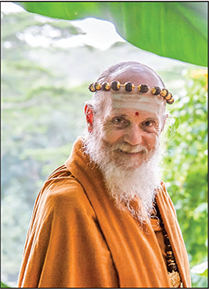 ALL TOO OFTEN, HINDU CONCEPTS AND practices are explained to children and youth as rules rather than as tools. Rules restrict what we can do in life and have the sense of making things less enjoyable. Kids, especially, rebel at too many rules. Tools, on the other hand, make them more effective and improve their quality of life. We can transform cumbersome rules into appealing tools by clearly explaining the processes involved in a practice or custom and the benefits it has to offer. The object is to catch the child’s interest, to show how Hinduism will help her make spiritual progress and enjoy a happier and more successful life. It is inspiration, not rules, that drive people forward, and children are no different in this regard.§
ALL TOO OFTEN, HINDU CONCEPTS AND practices are explained to children and youth as rules rather than as tools. Rules restrict what we can do in life and have the sense of making things less enjoyable. Kids, especially, rebel at too many rules. Tools, on the other hand, make them more effective and improve their quality of life. We can transform cumbersome rules into appealing tools by clearly explaining the processes involved in a practice or custom and the benefits it has to offer. The object is to catch the child’s interest, to show how Hinduism will help her make spiritual progress and enjoy a happier and more successful life. It is inspiration, not rules, that drive people forward, and children are no different in this regard.§
Imagine a teenager challenging her parents about three family practices: “Why are we vegetarian?” “Why do we need to go to the temple every week?” “Why can’t I listen to hip hop music like my friends do?” Unfortunately, parents may not take the time to give thoughtful, complete answers to such questions, and instead take the easy route, decreeing, “It’s what our family has always done.” Because many of their friends don’t have to follow such a strict code of conduct, youth hearing this answer can easily conclude that Hinduism is a just a set of rules that makes life restrictive and unhappy.§
Before answering these questions in a way that transforms them from rules into tools, let’s review some basic concepts. These are what I call “big ideas.”§
Two Big Ideas§
The first big idea is that everything affects our consciousness. My guru’s guru, Yogaswami of Sri Lanka, explained: “What you think, that you become. If you think God, you become God. If you think food, you become food. Everything influences consciousness.”§
The second big idea is that each of us is a soul, a divine being living in a physical body, and we have a threefold nature. At the deepest level, we are a pure, radiant, blissful soul. That is our spiritual or intuitive nature. We also have an intellectual nature and an instinctive nature. So, we have three aspects: spiritual (knowing, being), intellectual (thinking) and instinctive (feeling). The instinctive nature consists of our lower, animal instincts, such as self-preservation, procreation, hunger and thirst. It also includes the emotions of greed, hatred, anger, fear, lust and jealousy. This is our desire/feeling nature. The intellectual nature is our faculty of reason and logical thinking. It is the source of discriminating thought. The intuitive nature is the mind of light, of omniscient knowing, omnipresent awareness, pure consciousness, truth and love. This is our spiritual nature.§
Using this pair of big ideas, we are now ready to answer the three questions.§
Why Are We Vegetarian?§
In India, vegetarianism is well established, and not eating meat is seldom a target for criticism. In other countries, however, being a vegetarian is the exception, and vegetarian children are often the brunt of ridicule, peer pressure and chiding. Adding injury to insult, in most school cafeterias and at social events, veggie options are meager, unimaginative and unhealthy. There is practically nothing a vegetarian student can eat!§
Little wonder that children want to take the easy way out and abandon a vegetarian diet. However, there are compelling reasons for being a vegetarian. The main one is that eating meat affects their consciousness in a negative way, bringing them into the instinctive nature.§
Explain to children that if they want to live in higher consciousness, in their soul nature, in peace and happiness and love for all creatures, they cannot eat meat, fish, shellfish, fowl or eggs. The reason for this is that by ingesting the grosser chemistries of animal foods, one introduces into the body and mind anger, jealousy, fear, anxiety, suspicion and the terrible fear of death, all of which is locked, biochemically, into the flesh of butchered creatures.§
In other words, meat eating will strengthen their instinctive nature and make them more prone to these lower emotions. By eating meat, they will become angry more often and experience darker moods. My guru stated, “Vegetarianism is very important. In my fifty years of ministry, it has become quite evident that vegetarian families have far fewer problems than those who are not vegetarian.” Children who are awakening to this understanding all over the world are becoming vegetarians all on their own. And these days, with a GPS-enabled iPad, a little research and creativity, vegetarian options can be discovered just about anywhere.§
Why Must We Go to the Temple Every Week?§
Explain to children that worshiping in the temple is one of the traditional ways Hinduism gives us for connecting with our soul nature and experiencing ananda, the natural bliss of the soul. They can visit the temple in state of discontent, receive the blessings of God and the Gods and go away uplifted and happy. How is this possible? The Deity’s blessings have cleared their mind and aura of congested thought forms and emotions, allowing them to reconnect with their inner self. The blessings lift them out of their instinctive nature and soften their intellectual nature, bringing them into their spiritual nature.§
Once children catch the idea that temple worship is a great tool for stabilizing their emotions when they get upset, their reluctance to join the family will change. The temple will become important to them, not just to mom and dad. Temple worship will help them remain calm and centered even in difficult circumstances. They will find that going in the right spirit is a way of pulling themselves back together. It is also a place for assuaging long-held hurts.§
Teach children to go to the temple and place their problems at the feet of the Deity, to bring offerings and talk to the Deity about their unhappiness, just as if they were talking to a friend in this physical world. There, with the Deity, they will go through a deep, inner process and receive blessings from the Deity if they open themselves in the right way. They may find that when they leave the temple they can’t remember what the problem was. That’s a sign of success.§
Of course, the benefits of attending a temple every week are not limited to times that they are emotionally upset. Even when everything is going well in their life, worshiping at the temple with sincerity and attentiveness takes them deeper into their soul nature. They will be more compassionate and understanding, better able to deal with the challenges that come to them in life. Once your child realizes that worship is a powerful Hindu tool, and not just another adult rule, she will ask you to take her to the temple every week.§
Why Can’t I Listen to Hip-Hop Music?§
Music, especially when listened to for extended periods, strongly influences our state of consciousness. Whatever children listen to brings them into one state of consciousness or another. My guru, Satguru Sivaya Subramuniyaswami, was outspoken on this topic. He felt that the type of music played in the home and the message it delivers are crucial. He stated that great care should be exercised to exclude the crass music and lyrics of lower consciousness. “The drug culture and its demonic music erode the very fabric of human character and culture.” If your child catches this idea, her musical preferences will evolve—not because of rules you impose, but because she understands how different kinds of music influence her mood and mind. At the very least, she will avoid crude, negative hip-hop and listen only to the genre’s higher strains. Ideally, the music played in the home should be beautiful Hindu music played on traditional instruments, which takes everyone in the family into their refined and cultured soul nature.§
Tools Out-Perform Rules!§
Taking time to give sensible answers to your child’s questions about every Hindu practice is definitely worthwhile. Include in your explanation how the practice or restriction influences her consciousness. This will greatly increase the chances of her enthusiastically following the practice. And in some instances, your child will become inspired to urge other Hindu youth to give it a try as well!§
PUBLISHER’S DESK • JANUARY 2008§
How to Improve the World
______________________§
Three attitudes to help us cope with our planet’s conflict-ridden condition and one strategic, long-term way to change it§
______________________§
BY SATGURU BODHINATHA VEYLANSWAMI§
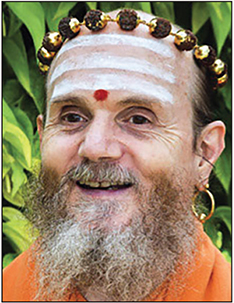 RECENTLY A GROUP OF DEVOTEES LAMENTED to me about the dreadful condition of the world, asking my opinion about the best perspective those on the spiritual path can hold. It is certainly on everyone’s mind, with all the unusual problems we face. My answer was that there are multiple viewpoints we need to hold. One is that, yes, it is good to try to improve conditions, while keeping expectations reasonable. A second point of view we can remember is that trying to change the world is a little like trying to straighten a dog’s tail. It keeps going back the way it was, no matter what you do. The key is to find the right balance between working to improve the world and accepting it as it is, knowing that you can’t totally transform it overnight and that change does not come easily.§
RECENTLY A GROUP OF DEVOTEES LAMENTED to me about the dreadful condition of the world, asking my opinion about the best perspective those on the spiritual path can hold. It is certainly on everyone’s mind, with all the unusual problems we face. My answer was that there are multiple viewpoints we need to hold. One is that, yes, it is good to try to improve conditions, while keeping expectations reasonable. A second point of view we can remember is that trying to change the world is a little like trying to straighten a dog’s tail. It keeps going back the way it was, no matter what you do. The key is to find the right balance between working to improve the world and accepting it as it is, knowing that you can’t totally transform it overnight and that change does not come easily.§
A third, more philosophical, view to hold is that everything is as it should be. Humanity’s plights and predicaments all have a divine purpose. In striving to improve the world, we don’t want to feel that things are not supposed to be the way they are. We may wish it were different but, in fact, it is a natural playing out of what has been set in motion in the past. We can, to a limited degree, direct and guide the flow of events and encourage things to play out in a better way, but the forces of past actions still continue to powerfully influence and define the present. Those with spiritual insight know that the world is in a perfect state of evolution at every point in time.§
In the months after 9/11, visitors meeting with me in our guru temple here on Kauai would often ask, “What do you think about these terrible events?” Their sense was that conditions had never been worse. Reflecting back on recent history, I responded, “Well, times have been worse. All you have to do is go back to World War II. We were not just fighting terrorists who hijack somebody else’s airplane. We were fighting Japan and Germany, two very powerful military bodies with thousands of planes, who were causing havoc in the world. Over sixty million people were killed in that war, mostly civilians. That was a far more serious problem by comparison.”§
Europe gives us another example. For as long as history tells her story, European countries were fighting one another. But what are they doing today? They are working together as the European Union. They’ve joined together. Do we foresee Germany attacking England ever again? No. A change in consciousness took place in Europe. That’s a good sign, and it’s just one example of how the world is changing for the better.§
The Roots of Conflict: The fundamental challenge is the tendency to divide the world into “we-they” rather than maintaining the inclusive “we” perspective. In the “we-they” perspective, “they” are different than we are, and we tend to emphasize all of their unseemly or negative qualities. If we strive to keep everything as a “we” and maintain the principle of inclusiveness, then we minimize that tendency. All groups have the tendency to polarize and split. Even a large family will split into “we-they.” It is a natural tendency of humankind to divide into two groups that have problems with one another. “We” consciousness is strengthened by focusing on what is held in common. “We-they” consciousness is strengthened by focusing on differences. §
An ultimate “we” consciousness has been experienced by several astronauts when looking at Earth from outer space, seeing mankind’s commonality rather than dissimilarity. Sunita Williams’ experience during her 195 days on the International Space Station space in 2007 radically altered her perspective of life. From 350 km in orbit, the earth appears a magnificently beautiful whole. She says: “It is hard to imagine people arguing down there, not to mention fighting. It looks so peaceful... so calm down on Earth. From space, there are no borders that you can see. We are lucky to live on such a planet and we should not take it for granted. After my space experience, I am a lot more tolerant of people and opinions, of everything.”§
How do we solve, or at least minimize, the tendency to divide us? Through persistently teaching the opposite. Our Gurudeva, Satguru Sivaya Subramuniyaswami, took a simple step by creating large granite signs for the island of Kauai that say, “One Island, Many Peoples, All Kauaians.” These were installed by the county at prominent locations to emphasize the unity of all the many peoples of Kauai. He created similar signs for Mauritius to strengthen unity, because in every community there is the tendency to split. In the Kauai community the tendency is to divide according to ethnic background.§
Gurudeva was inspiring acceptance and counteracting the force of prejudice. He knew that prejudice toward those who are of a different race, nation or religion can start simply as distrust and then deepen into dislike and deepen further into hatred, which can turn into a compulsion to inflict injury.§
Are children born with attitudes of prejudice and hatred? No. They learn such things at home, from their family and friends, and at school from teachers and classmates. Prejudice toward other ethnic groups, religions or nations is even taught in religious institutions. §
The long-term solution, one that will take many decades, is to instill prejudice-free consciousness in future generations. People who are older are set in their ways and unlikely to change. But each new generation starts out with a blank slate. Children can be taught tolerance, acceptance and openness toward those who are different. With each new generation, we have an opportunity to teach positive, unifying beliefs. And one of the biggest changes that can take place in society occurs as members of a new generation mature into positions of influence and power. If they are imbued with unbiased, spiritual attitudes, conditions in the nations they serve in will improve. §
This is where opportunity lies, in encouraging parents to raise their children in such a way that they are free of prejudice. And then do it again with the next generation, and then do it again and again. Do that for enough generations and we will change the world in a major way. But it takes time. We can all help in our own spheres of influence—family, friends, work, community—doing our part to instill a prejudice-free consciousness in youth and thus transform attitudes that divide peoples, neighbors and nations.§
Dr. Martin Luther King, Jr. expressed the goal eloquently, “I have a dream that one day my children will be perceived for the content of their character rather than by the color of their skin.” That is the point, to see the person, not their ethnicity or their religion and impose negative generalizations on them. Even positive generalizations and preconceived notions should be avoided, as they, too, obscure this genuine interaction. For example, some say the Chinese are industrious. But, in truth, not all Chinese are hard-working, and even thinking in such positive stereotypes prevents you from seeing an individual as he or she is. §
There are two cardinal principles that naturally motivate Hindus to be free of prejudice and not fall into the “we-they” consciousness. The first is that every person is a divine soul. Even a terrorist or a criminal is a divine being, though one needing many lives of further evolution. There are no people who are evil intrinsically. Their behavior may be evil, destructive, but everybody is divine on the inside. Therefore, everybody is important. Even the terrorist is important; even the criminal is important. They deserve to be encouraged to come up in consciousness. It is the duty of spiritual people to strive to lift everyone up in consciousness, whether they are for us or against us.§
The second Hindu principle that inspires prejudice-free consciousness is that the whole world is a one family: Vasudhaiva kutumbakam. That is a powerful statement, because everyone understands family. When we say the whole world is family, we mean that we hold the same positive, loving attitude toward everybody that we do toward our own kinfolk. We want them to be happy, do well and prosper. Saying and believing that the whole world is our family confers an attitude that excludes no one.§
Underlying these two concepts is the knowledge of reincarnation and karma. Change and evolution occur over many lifetimes. The purpose of human birth is to grow and learn in the great school of earthly experience. Karma, the law of cause and effect, is the great and always just teacher. All souls are on this wondrous journey, whether they know it or not. Gurudeva used to say, “You have to be careful whom you hate, because you might end up being born in that group in your next life.” Thus you will see what it’s like to be on the other end of your hatred.§
Summary: I find it clarifying to hold three complementary attitudes toward the world. First: we do want to try and improve it. Second: we want to remain realistic about how much and how quickly it will change. Third: we strive to accept everything that is as the way it should be, even though it may not be the way we would prefer it to be. It is the way it is because of what has happened in the past. A Buddhist monk put it well: “The world is perfect, with plenty of room for improvement.” To gradually make the world a more peaceful place, we can spread the idea of raising children with a prejudice-free consciousness. Less prejudice means less hate; less hate means less violence. While we can’t change the world overnight, we can change it over many generations.§
PUBLISHER’S DESK • APRIL 2016§
Growing Up without Prejudice
______________________§
Conflict and violence have their roots in hatred learned during youth. By teaching children tolerance, we create a more peaceful future.§
______________________§
BY SATGURU BODHINATHA VEYLANSWAMI§
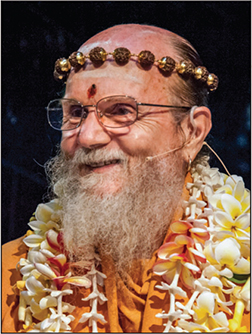 CONDITIONS IN THE WORLD TODAY ARE deeply troubling—wars between countries, profound social conflicts within countries, and almost daily incidents of terrorist acts. The shocking series of coordinated assaults in Paris on November 13, 2015—France’s deadliest attack since World War II—has Western nations on high alert. Attacks in Africa and Asia, while less publicized, are even more common, and equally devastating. The vicious hatred expressed by extremists toward those they seek to destroy dominates the news. Watching reports of these tragic events, we are reminded of how prejudice—and its big brother, malice—can change the world for the worse.§
CONDITIONS IN THE WORLD TODAY ARE deeply troubling—wars between countries, profound social conflicts within countries, and almost daily incidents of terrorist acts. The shocking series of coordinated assaults in Paris on November 13, 2015—France’s deadliest attack since World War II—has Western nations on high alert. Attacks in Africa and Asia, while less publicized, are even more common, and equally devastating. The vicious hatred expressed by extremists toward those they seek to destroy dominates the news. Watching reports of these tragic events, we are reminded of how prejudice—and its big brother, malice—can change the world for the worse.§
Attitudes of prejudice toward those of a different race, nation or religion can start simply as distrust, then deepen into dislike and fester into hatred, which can turn into an instinctive impulse to inflict injury. Are we born with such attitudes? Certainly not. As children, we are taught them at home, at school and, especially sadly, even in some religious institutions. Many people are raised to hate those of different ethnic groups, faiths or countries. Parents and radical teachers instill that hatred in the young innocents, often perpetuating centuries-old antagonisms.§
The way in which our children shape the future will depend upon the qualities of character we cultivate in them. Therefore, in the long run, our most effective personal solution to violence in our modern world is to dutifully nurture what our children are learning as they grow up. My Gurudeva, Sivaya Subramuniyaswami, spelled this out in a message he gave to 700 religious and political leaders in 1990 at the Global Forum for Human Survival, Development and Environment in Moscow: “We need, in the century ahead, to teach all children tolerance, openness to different ways of life, different beliefs, different customs of dress and language. We need to stop teaching them to fear those who are different from themselves, stop teaching them hatred for peoples of other colors and other religions, stop teaching them to see the world as a field of conflict, and instead instill in them an informed appreciation and a joyous reverence for the grand diversity we find around us.”§
For too many nations, cultures and faiths this is easier said than done. Animosities built up over the decades between opposing groups are so entrenched that even peaceful coexistence seems impossible. Then there are factions who, believing their way is the only way and their enemies are disposable, justify and glorify their hatred and intolerance. Gurudeva explained, “When the fundamentalists of any religion teach an unrelenting duality based on good and evil, man and nature or God and Devil, this creates friends and enemies.”§
Hinduism, with its long history of tolerance, can take steps to strengthen its exemplary commitment to nonviolence and to set examples for others. Above all, we must not fall prey to the instinctive, reactionary fears and violent urges that are tearing apart so many nations, communities and families today.§
Instead of teaching our children to be intolerant—to dislike and distrust, hate and inflict injury on those who are different—we must teach them to be tolerant, to like and trust, befriend and help. The quality we urge parents to develop in children is a prejudice-free consciousness, an open-mindedness that readily embraces differences in ethnicity, religion and nationality.§
The central place to cultivate this virtue is in the home. Every father and mother is, in fact, a child’s first guru, teaching by example and explanation, giving advice and direction. Secondarily, this important attitude should be discussed and strengthened in classes at the temple and in school, and encouraged through community activities that expose children to diverse cultures.§
Tolerance is nurtured through teaching children to appreciate the positive qualities of others, and by completely avoiding prejudiced remarks in the home against any race, religion or nationality. It is helpful to discuss with our children any bigoted comments they hear at school and elsewhere and be a gentle voice of wise correction. We must teach them to think of people as unique, divine individuals with an array of karmas and qualities that make them who they are.§
Even positive stereotypes can embolden a sense of otherness and should be avoided. TV and movies can provide useful learning moments to discuss such matters with children, not leaving them to make their own youthful conclusions. Tolerance can be developed by having them meet, interact and learn to feel comfortable with children of other nationalities, ethnicities and religious backgrounds. Hindu organizations can be proactive by organizing culturally enriching activities and outings for the children of their members. Fortunately, fewer and fewer things are strange to the children of this Internet era. Their exposure to borderless knowledge gives them an innate sense of planetary citizenship. Sometimes we need only nudge them in that direction. One key lesson to pass on to the children is this: we need not feel threatened by our differences.§
Sri Sri Chandrashekharendra Saraswati, Shankaracharya of Kanchi, expressed this beautifully in “Maithrim Bhajata,” an ode to universal brotherhood, which was performed by MS Subbulakshmi at the 50th anniversary of the United Nations in 1966. In English (translated by Lakshmi Chandrashekar Subramanian, who sings it here: bit.ly/MaithrimBhajata) it reads:§
“Cultivate friendship, which will conquer the hearts of all. Look upon others as thyself. Renounce war, renounce competition. Renounce aggression on others’ properties. Mother Earth is abundant and ready to give us all that we desire. God, our Father, is very compassionate to all. So, restrain yourself, donate your wealth, be kind to everyone. May all people of this world be happy and prosperous.”§
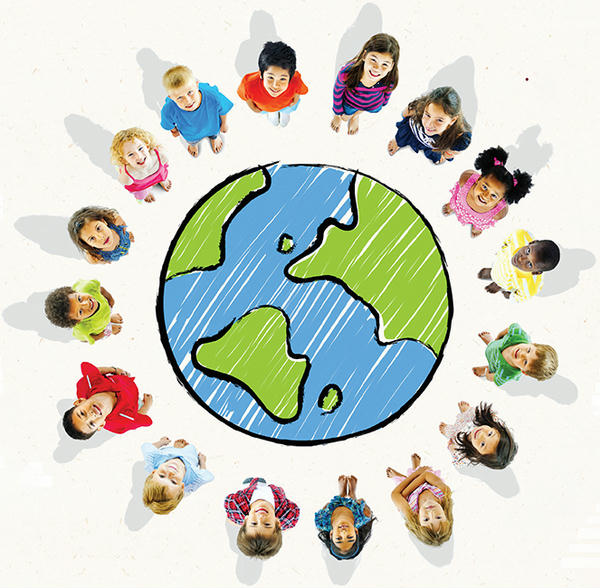
Leaders of the future: (left) Children born in the new millennium have a more profound global consciousness than earlier generations, a native sense of the oneness of the human family (photo by Shutterstock).§
A few key Hindu beliefs provide the basis for millennia of Hindu tolerance. The first is embodied in an ancient verse from the Rig Veda (1.164.46): Ekam sat viprah bahuda vadanti, “Truth is one; sages express it variously.” Hinduism has a wide diversity of traditions, but followers of the different paths respect one another and worship side by side in many temples. We have four major denominations. To Saivites, the Supreme is Siva. Shaktas refer to the Supreme as Shakti. Smartas call the Supreme Being Brahman; and to Vaishnavas He is Vishnu. However, the important point is that each Hindu is worshiping the same Supreme Being. The name is different, the tradition is different, but the same Supreme Being is being worshiped by all Hindus.§
This statement from the Vedas can be expanded beyond Hinduism to include all the world’s religions. In fact, a Tamil verse often chanted in Siva temples states, Tennadudaiya Sivane Pottri; Ennattavarkum Iraiva Pottri. This translates as: “He who is praised as Siva in the South of India is praised everywhere else as God.” What this means is that people around the world worship the Supreme Being, and Siva is one of the many names of God. Gurudeva said it simply, “Saivites profoundly know that God Siva is the same Supreme Being in whom peoples of all faiths find solace, peace and liberation.”§
He wrote: “Hindus also believe that there is no exclusive path, no one way for all. Religious beliefs are manifold and different. Hindus, understanding the strength of this diversity, wholeheartedly respect and encourage all who believe in God and do not seek to interfere with anyone’s faith or practice. Since the inner intent of all religions is to bind man back to God, Hindus honor the fact that ‘Truth is one, paths are many.’ Nonetheless, Hindus realize that all religions are not the same. Each has its unique beliefs, practices, goals and paths of attainment, and the doctrines of one often conflict with those of another. Even this should never be cause for religious tension or intolerance.”§
Another belief that gives rise to Hinduism’s innate acceptance and open-mindedness is that all of mankind is essentially good, that we are all divine beings, souls created by God. Hindus do not accept the concept that some people are evil and others are good. The Upanishads tell us that each soul is emanated from God, as a spark from a fire, then begins a spiritual journey that ultimately leads back to God. All human beings are on this journey, whether they realize it or not. Gurudeva noted, “This basic belief creates the attitude of sublime tolerance and acceptance toward others. Even tolerance is insufficient to describe the compassion and reverence the Hindu holds for the intrinsic sacredness within all things.” So when a Hindu sees a person who is performing horrible deeds, whom others call bad or evil, he thinks to himself, “This is a young soul, acting in terrible ways, but one day, in the course of many lives, he will realize his errors, atone and adhere to dharma.” By greeting one another with namaskara, palms held together to honor God within the other person, Hindus practice this truth on a daily basis. The Upanishads assure us, Ayam atma Brahma, “The soul is God.”§
There can be no denying that we live in tumultuous times, with millions of people being forced to leave their homelands as refugees from terror, victims of bigotry and hatred. But let not the vicissitudes of politics and regional turmoil shake us from the basic truths on which Hinduism stands. Instead, let us bravely persist in passing on to the next generations the all-too-rare virtue of prejudice-free consciousness so that they may, as leaders of the future, shape the world into a more peaceful place.§
